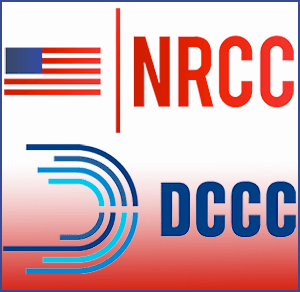Last week, Anne Brady, former finance director of the Democratic Congressional Campaign Committee, analyzed the House races from her perspective. Today, Jeff Burton, the Deputy Executive Director of the National Republican Congressional Committee, offers the GOP analysis.
House Democrats held a press conference last Thursday where Minority Leader Nancy Pelosi proclaimed that her party has a “very excellent chance” of winning the majority in the upcoming general election. There’s just one problem – just about every pundit disagrees. Even other Democrat Party leaders fail to share their former Speaker’s opinion. Whoops. Last Monday, Senate Democratic Whip Dick Durbin (IL) said he expects the House to remain in Republican hands, and Robby Mook, Executive Director of the DCCC, said just a few weeks ago, “Today, we are in a neutral environment. It is a pretty steep climb in a neutral environment. It’s tough.”
Democrats need to pick up a net of 25 seats to take control. With a month and a half before Election Day, Republicans stand an excellent chance of not only keeping control, but also gaining seats and expanding our majority in the House.
Here’s why:
History is on Our Side – Only once since WWII has the party holding the White House gained more than 15 House seats in a presidential election year. That was in President Johnson’s 1964 landslide win over Sen. Barry Goldwater. President Obama’s negatives (ObamaCare, Cap & Trade, stimulus, economy & jobs) are so ingrained with voters that there is virtually no chance of a Democratic landslide.
Republicans on Offense – In 2010, the NRCC spent over 98 percent of our election money on offense. Going in to 2012, our strategy was to stay on offense and not let the Democrats spend the bulk of their money in Republican seats. Currently, of the $50+ million that the NRCC has reserved for TV this fall, we are spending 40 percent of it on offense, with Democrats following us in most places in an attempt to defend their endangered seats. Needless to say, a majority is not won by spending the bulk of your resources playing defense.
Message – Recent polling shows voters are putting more and more blame for the bad economy on President Obama. The Obama economy has precipitated the worst economic recovery in our nation’s history, and voters aren’t ready to let Democrats get away with it. Despite the Supreme Court ruling, ObamaCare is still an albatross around the necks of congressional Democrats. The Congressional Budget Office just upped both the overall cost of ObamaCare and the commensurate amount of Medicare cuts for current seniors that offset the massive new federal expenditure. Our message of reducing spending & debt, creating jobs, and repealing and replacing ObamaCare continues to resonate with voters. Our incumbents and candidates have done a great job of communicating this message.
Resources – The Democratic Congressional Campaign Committee (DCCC) talks a lot about how they have out-raised the NRCC for the cycle. But, as any small business owner will say, ‘you can’t spend gross, you can only spend net’. According to the last report (end of August), the NRCC had $10 million more cash-on-hand than the DCCC. What does $10 million buy? It buys a month of television in Chicago, Sacramento, Denver and Las Vegas: all expensive markets where both parties are playing both offense and defense in multiple districts.
The Drive for 25 – This was the slogan the Democrats came up with after they lost the majority in record-breaking fashion back in 2010. Their math, however, doesn’t add up. Because of redistricting and key Democrat retirements in seats like OK-2 (R+14), AR-4 (R+9) and NC-13 (R+10), Republicans have a number of “gimmies” that we should pick up without spending any money. This, coupled with DCCC recruiting failures in seats in New York, Arkansas, Pennsylvania, California, Illinois and Florida, and redistricting victories in North Carolina and across the country, provides the basis for every non-partisan political analyst (and even the liberal New York Times) to say that Democrats really need to pick up somewhere between 35-40 Republican seats to win the majority.
All these factors lead to a neutral political environment. Head to head, I would take our incumbents and challengers over theirs any day. So Nancy Pelosi’s “very excellent chance” to take back the House is nothing more than a pipe dream. She won’t be wielding the Speaker’s gavel anytime soon. Hopefully, she never will again.
 Feb. 12, 2019 — Countering the previously announced National Republican Congressional Committee Patriot Program targeting list, the Democratic Congressional Campaign Committee released their Frontline Program protection listing late last week.
Feb. 12, 2019 — Countering the previously announced National Republican Congressional Committee Patriot Program targeting list, the Democratic Congressional Campaign Committee released their Frontline Program protection listing late last week.

